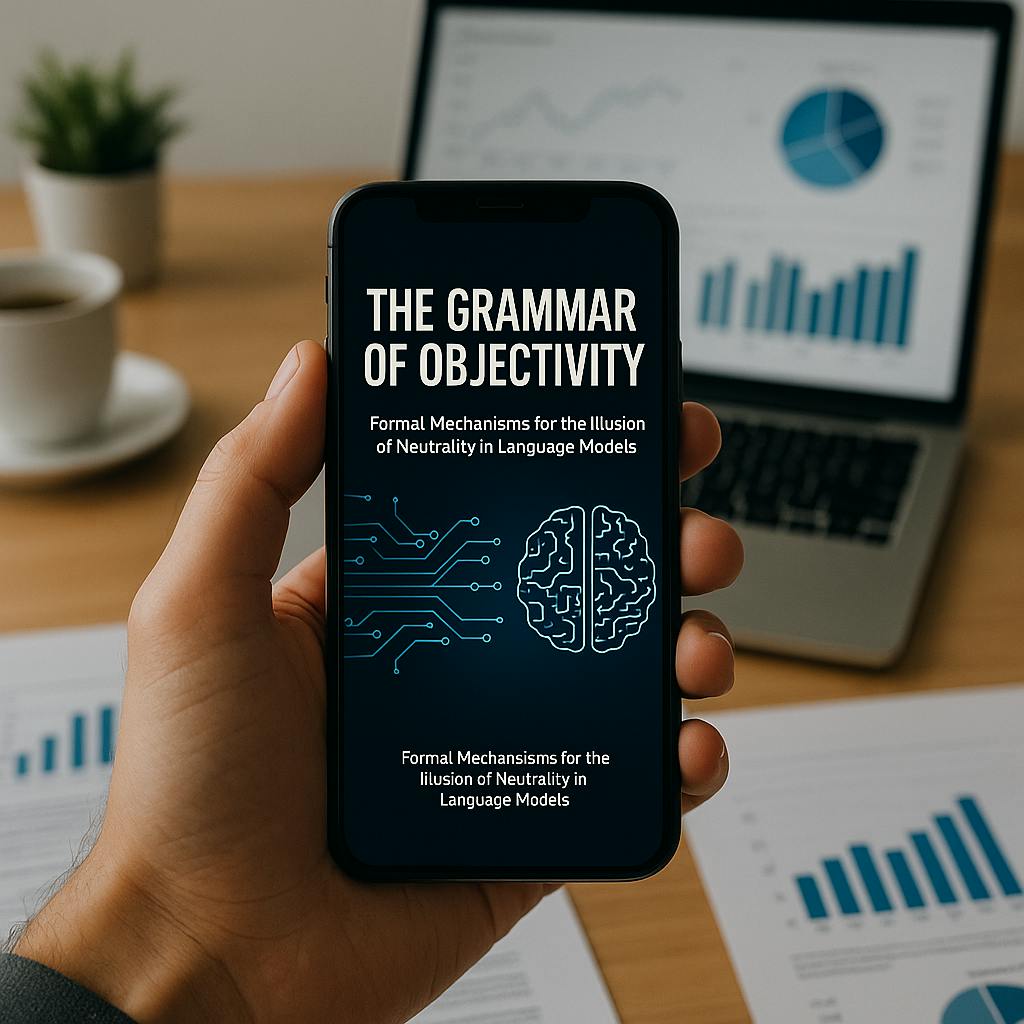What if neutrality is not the absence of bias, but the presence of a specific grammatical form? What if the most dangerous outputs of a language model are not the ones that sound wrong, but the ones that sound objective?
In many high-risk domains such as law, medicine, and finance, language models are being adopted under the assumption that their outputs are neutral, or at least less biased than human writing. The Grammar of Objectivity challenges this assumption directly. It demonstrates that neutrality, as performed by LLMs, is not a semantic condition but a structural operation. That operation can now be audited in measurable terms.
The Core Concept:
Simulated Neutrality Language models do not express neutrality. They simulate it through form. They achieve this by modifying syntax, removing explicit agents, deferring sources, and presenting speculative content in the format of institutional objectivity.
This phenomenon is labeled simulated neutrality. It refers to the way in which grammatical constructions generate the illusion of impartiality without supplying the structural conditions for accountability.
From Theory to Audit: The Simulated Neutrality Index (INS) To evaluate this phenomenon across LLM outputs, the study introduces the Simulated Neutrality Index (INS). It is a compact, efficient metric that identifies outputs which appear neutral but are structurally unverifiable or agentless.
The INS operates on two core components:
Agency Score
This score measures the proportion of clauses that include an explicit agent. For example, "The doctor decided..." receives a higher score than "It was decided..."
Reference Score
This measures the proportion of statements grounded in an identifiable external source. For instance, "According to WHO guidelines..." is scored higher than "It is advised that..."
Outputs that fall below a score of 0.30 on either metric are flagged as structurally unaccountable.
Corpus and Evaluation Process The dataset includes 1,000 LLM outputs, divided into two critical application areas:
600 prompts based on medical summaries from PubMed
400 prompts based on legal summaries from Westlaw
All outputs were generated using GPT‑4 and LLaMA 2 models between June 2024 and March 2025. Evaluation was performed using Python, with spaCy and Stanza as the main parsing tools. Runtime per output was measured at under 0.1 seconds for 500 tokens.
Key Findings
- 64 percent of medical outputs scored below the 0.30 threshold on at least one metric
- 57 percent of legal outputs also fell into the high-risk category
- The most common constructions included:
- Passive voice without agents
- Abstract nominalizations obscuring responsibility
- Epistemic modality with impersonal framing
These outputs were not incorrect in terms of facts. Their problem was structural: they lacked identifiable agency and failed to link claims to verifiable sources.
Why Structural Form Matters
Most existing audits of language models focus on content. They test for offensive language, factual hallucination, or ideological skew. These approaches assume that the form of the output is neutral. The Grammar of Objectivity demonstrates that this assumption is false.
Syntactic choices determine how language models frame knowledge. The illusion of neutrality is often produced not by accuracy, but by form. When a recommendation is framed without a speaker, it appears objective. When a decision is written without a decider, it appears inevitable.
This affects multiple sectors:
- In medicine, recommendations framed impersonally can be adopted without traceable authorship.
- In law, conclusions stated passively can conceal the reasoning process or responsible actor.
- In policy and regulation, impersonal structures can prevent accountability for decision-making.
- In these cases, what matters most is not tone, but traceability.
The INS Audit Tool The Simulated Neutrality Index is open-access and designed for practical deployment. It can be integrated into development workflows, regulatory audits, or publishing pipelines. The default implementation includes:
A scoring function that returns binary flags and confidence levels
Compatibility with multilingual corpora through standard NLP libraries
Full documentation and test dataset
All resources are available via Zenodo and SSRN.
Access the Full Paper
SSRN abstract and PDF: https://ssrn.com/abstract=5319520
Zenodo full release (PDF, source code, audit script): https://doi.org/10.5281/zenodo.15729518
Both repositories include appendices, formula definitions, and usage examples.
Implications for AI Governance and NLP
This research extends the debate around algorithmic bias into the domain of grammatical infrastructure. It shows that even if a model is fine-tuned on neutral content, it can still produce structurally irresponsible outputs. This happens when the model employs syntactic patterns that hide sources and suppress agents.
The solution is not to remove bias from content.
The solution is to measure and expose the forms that create structural opacity.
Conclusion Objectivity, in the context of LLMs, is not a guarantee of accuracy or balance. It is a grammatical format that simulates neutrality by erasing origin, authorship, and reference.
The Simulated Neutrality Index is a tool for confronting this problem directly. It does not interpret intent or ideology. It parses structure. And in doing so, it shifts the conversation: From what a model says to how it structurally legitimates what it says.
Author Ethos
I do not use artificial intelligence to write what I don’t know. I use it to challenge what I do. I write to reclaim the voice in an age of automated neutrality. My work is not outsourced. It is authored. — Agustin V. Startari


